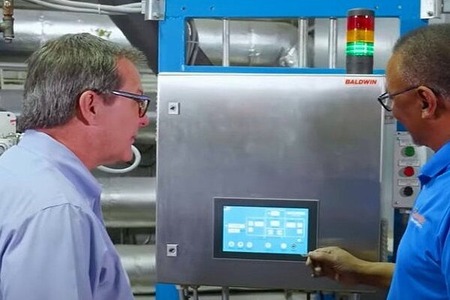
Chinese textile and apparel to adapt ‘New Normal’ strategy
YarnsandFibers News Bureau 2015-12-07 14:00:00 – BeijingWith China’s production and labor costs in the textile and apparel industry rising dramatically and exceed those in of many other Southeast Asian countries, including Malaysia, the Philippines, Indonesia and Vietnam is the cause of China losing the competitive edge in mass production. China is changing its strategy by adapting to ‘new normal’.
According to Zhang Tao, the secretary general of the Sub-Council of Textile Industry (CCPIT), The Textile Industry Chamber of Commerce (CCOIC), the ‘new normal’ situation implies the reality of slower growth rates … in China’s economy, coupled with spiraling costs that are going out of control.
Last year, China processed approximately 10 million tons of cotton, 60 percent of which was grown locally. The remainder was imported from countries including the United States, India, and Pakistan. Even as China imports textile and apparel products from Bangladesh, Pakistan and other countries, textile and apparel exports continue to be the number one contributor to China’s foreign trade, with China’s biggest markets the United States, the European Union and Japan. Also, many Southeast Asian exporters import China-made fabrics and re-export them after further processing.
China’s total export value of textiles and apparel from January 2015 to May 2015 reached just $30 billion, with the United States accounting for some $16.4 billion in that period compared to 2014, the total export value of textiles and apparel amounted to roughly $300 billion, according to the CCPIT data.
However, U.S. demand for textiles and apparel seemed to be picking up, but at a slower pace. It is difficult for suppliers of low-end products [to find demand in the United States] because of the fierce competition and the cost-conscious U.S. consumer’s self-restraint in buying. However, the U.S. market is much more resilient and stronger than the European Union’s and Japan’s. Recovery is, however, not that strong as buyers are not ordering as much as they used to, said Tao.
As the traditional markets seem to be saturated, Chinese exporters are also looking for greener pastures elsewhere, particularly in the emerging markets of South America, including Brazil, with its 300-million-strong population, and Russia, though the latter has problems vis-a-vis the sanctions it faces. Tao noted that Africa was also opening up to Chinese exports.
China is also looking for production sites beyond its shores — migration that typically was more focused on apparel than textile production to counter the sharp rise in production and labor costs. Fabric production is not labor intensive but apparel production is. Chinese companies are worried by rising labor costs and one way to remain competitive in the world markets is by shifting production to low-cost sites, Tao explained.
Chinese companies are looking to set up full manufacturing bases in the markets they wish to serve. Toward that end, Chinese textile companies have been buying out manufacturing assets such as mills in the United States, the most recent one in South Carolina.
This is a reversal of the mass sourcing of textile and apparel production from what was then a low-cost production site more than two decades ago. Textile production in China is no longer profitable for many manufacturers, both international and Chinese, who are turning their backs on China. In addition to rising wages and energy costs, production in China also involves higher logistics costs and requires dealing with government quotas on imported cotton, which creates a lot of uncertainty for manufacturers.
According to Tao, the scene and actors are changing too. If there was a huge interest on the part of many U.S. manufacturers-turned-importers in sourcing cheap products from China, it is the Chinese who are now flocking to the United States to manufacture.
The calculation by Chinese companies is that while U.S. labor costs are much higher, the productivity levels in the United States are also much higher, thus levelling off or even driving down the end costs in the final analysis. Other perks for Chinese manufacturers setting up shop in the United States come in the form of much lower energy prices, competitive prices of cotton, tax incentives from local governments and of course a reduction in shipping costs. Also, there is an opportunity to capitalize on the ‘made-in-America’ cachet, which is becoming increasingly desirable.
Additionally, the “keeping-a-foothold-in-the-market†strategy — producing goods in the market where they are sold — is appealing to many Chinese companies that are driven by the prospect of a trans-Pacific free trade market, which would result from the successful passage of the Trans-Pacific Partnership (TPP). The U.S.-led TPP agreement will include all of the major economies of the trans-Pacific region except China. And the fear of being shut out of the TPP has caused Chinese yarn companies to set up a base in the United States.
According to the International Textile Manufacturers’ Federation, yarn production costs in China have sharply risen, surging by as much as 30 percent compared to those of the United States. Of course, the Chinese are not moving just into the United States. They also have been shifting manufacturing to other lower-cost countries in Asia, particularly Bangladesh, India and Vietnam.
Chinese companies see multiple benefits accruing to them from their presence in the United States. Some Chinese exhibitors at the recent TexWorld show in New York told Apparel, on the condition of anonymity, that many Chinese companies found the United States an attractive manufacturing site because it offered unhindered and direct access to the huge U.S. market and noted that Chinese companies had so far made more than $45 billion worth of investments in new projects and acquisitions in the United States, with most of that in the past five years.
The Carolinas are proving to be a hot spot, with more than 20 Chinese companies having set up operations, including a polyester fiber plant opened by Keer and Sun Fiber in South Carolina in 2014.
Some Chinese companies also want to use their U.S. operations to ship yarn to apparel manufacturers in Mexico, Central America and the Caribbean — countries that have duty-free access to the American market under NAFTA and CAFTA, provided the yarn is produced in a member country.
The Chinese are taking lessons from companies in neighboring countries such as India, which recently have been making acquisitions or setting up shop in the United States. Indian textile manufacturer Shri Vallabh Pittie Group, for example, garnered a lot of attention when it opened a factory in Sylvania, Georgia.
The impact of new plants being opened or old ones being revived can be seen on local job markets. South Carolina, for instance, welcomed the arrival of Keer, as it employed weavers and spinners who had been laid off after Springs Industries shuttered its cotton mills — at one time some of the world’s largest.
Recently, Chinese specialty textile company Legend Athletic Wear LLC opened its first U.S. production unit in Cincinnati, Ohio. (Ohio had been competing with Oregon and California to bag the Legend project.) The company, which uses sublimation technology to color fabrics, is the North American subsidiary of a Shanghai, China-based Australian textile-specialty company.
Legend was founded by husband and wife co-owners Dr. Tan Kek Looi and Min Qi in 2005. From 2005 to 2012, the company’s sales grew from $84,000 to $1.8 million. Legend plans to invest more than $1.4 million in its new manufacturing facility. Indications are that the owners want to establish the Legend brand in the United States and later launch it in China.
By going with a strategy of geographic diversification, Chinese manufacturers are looking to beat the pricing pressures of its spiraling inflation.
.
Market Intelligence
Ask for free sample Report

experience
Customer Base
dedicated team
Countries Served Worldwide









